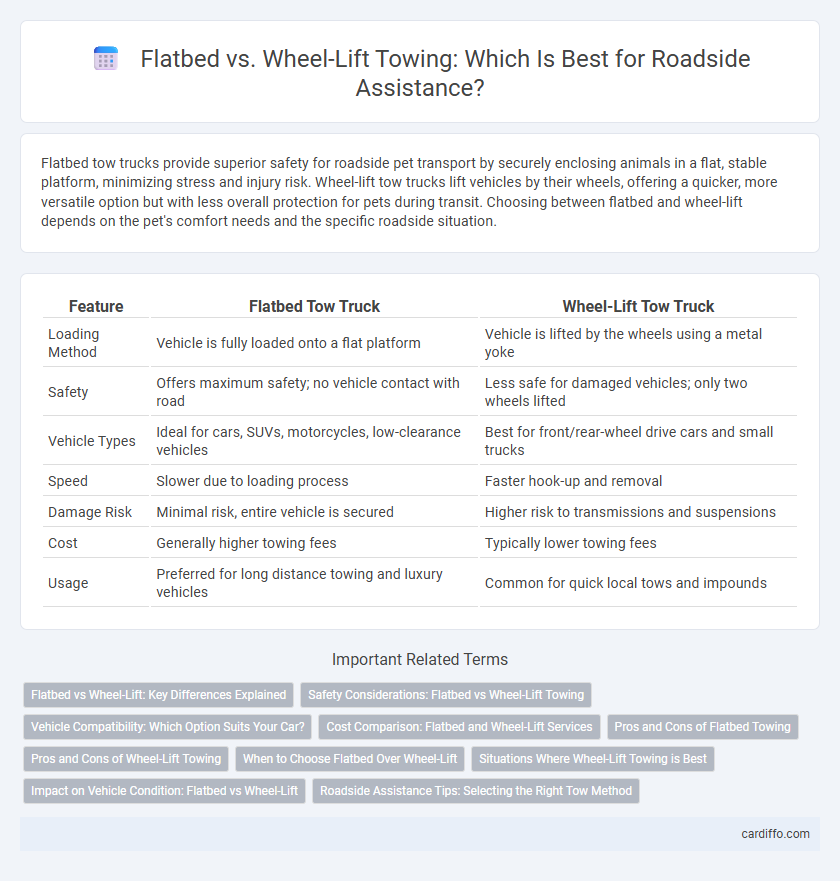Flatbed tow trucks provide superior safety for roadside pet transport by securely enclosing animals in a flat, stable platform, minimizing stress and injury risk. Wheel-lift tow trucks lift vehicles by their wheels, offering a quicker, more versatile option but with less overall protection for pets during transit. Choosing between flatbed and wheel-lift depends on the pet's comfort needs and the specific roadside situation.
Table of Comparison
| Feature | Flatbed Tow Truck | Wheel-Lift Tow Truck |
|---|---|---|
| Loading Method | Vehicle is fully loaded onto a flat platform | Vehicle is lifted by the wheels using a metal yoke |
| Safety | Offers maximum safety; no vehicle contact with road | Less safe for damaged vehicles; only two wheels lifted |
| Vehicle Types | Ideal for cars, SUVs, motorcycles, low-clearance vehicles | Best for front/rear-wheel drive cars and small trucks |
| Speed | Slower due to loading process | Faster hook-up and removal |
| Damage Risk | Minimal risk, entire vehicle is secured | Higher risk to transmissions and suspensions |
| Cost | Generally higher towing fees | Typically lower towing fees |
| Usage | Preferred for long distance towing and luxury vehicles | Common for quick local tows and impounds |
Flatbed vs Wheel-Lift: Key Differences Explained
Flatbed tow trucks feature a flat, horizontal bed that slides back to load vehicles entirely off the ground, minimizing damage risk during transport. Wheel-lift tow trucks use a metal yoke to lift the vehicle by its wheels, allowing faster hook-up but may cause stress on the tires and suspension. Understanding these operational differences is crucial for selecting the appropriate towing method based on vehicle condition and transport requirements.
Safety Considerations: Flatbed vs Wheel-Lift Towing
Flatbed towing offers enhanced safety by securely transporting vehicles entirely off the ground, minimizing the risk of tire or drivetrain damage during transit. Wheel-lift towing, while more maneuverable in tight spaces, carries higher risk for potential vehicle damage due to partial lifting and road contact of the towed vehicle's tires. Choosing between flatbed and wheel-lift tow trucks depends on vehicle type and safety priorities, with flatbeds generally preferred for long-distance or delicate vehicle transport.
Vehicle Compatibility: Which Option Suits Your Car?
Flatbed tow trucks offer superior vehicle compatibility by supporting cars entirely on a flat platform, preventing any contact with the ground and minimizing damage risks. Wheel-lift tow trucks lift only the front or rear wheels, making them suitable for rear-wheel or front-wheel-drive vehicles but less ideal for all-wheel or low-clearance cars. Choosing between flatbed and wheel-lift methods depends on your car's drivetrain, clearance, and the potential for undercarriage damage during transport.
Cost Comparison: Flatbed and Wheel-Lift Services
Flatbed towing services typically incur higher costs due to the specialized equipment and increased labor required to secure and transport vehicles safely, making them a preferred option for luxury or heavily damaged cars. Wheel-lift towing tends to be more cost-effective as it uses a metal yoke to lift the vehicle by its wheels, reducing operational complexity and time on site. Choosing between flatbed and wheel-lift often depends on budget considerations, vehicle type, and towing distance, with flatbeds generally commanding a premium price for enhanced safety and versatility.
Pros and Cons of Flatbed Towing
Flatbed towing offers superior protection by keeping vehicles fully elevated, reducing the risk of damage during transport. It is ideal for luxury, vintage, or all-wheel-drive vehicles, as it prevents wear on tires and drivetrains. However, flatbed towing can be more expensive and less accessible in tight urban areas compared to wheel-lift towing.
Pros and Cons of Wheel-Lift Towing
Wheel-lift towing offers quicker hook-up times and reduced risk of vehicle damage compared to flatbed towing, making it ideal for short-distance or emergency roadside assistance. However, wheel-lift systems may cause wear and stress on the towed vehicle's suspension and tires, limiting their use for long-distance transport or on vehicles with low clearance. Maintenance of wheel-lift equipment requires regular inspections to ensure safe lifting capacity and prevent hydraulic failures during towing operations.
When to Choose Flatbed Over Wheel-Lift
Flatbed tow trucks are preferred over wheel-lift models when transporting vehicles with extensive undercarriage damage or all-wheel drive systems to avoid further harm. They provide a stable, fully supported platform ideal for long-distance towing or relocating high-value cars. Flatbeds minimize the risk of tire and suspension damage, making them the optimal choice for luxury and antique vehicles requiring careful handling.
Situations Where Wheel-Lift Towing is Best
Wheel-lift towing is ideal for situations involving vehicles with low ground clearance, such as sports cars and luxury sedans, as it minimizes the risk of undercarriage damage. It excels in urban and tight spaces where maneuverability is crucial, allowing for easier navigation around obstacles and parked vehicles. Wheel-lift tow trucks are also preferred for short-distance tows and quick roadside assistance due to their faster hook-up times compared to flatbed trucks.
Impact on Vehicle Condition: Flatbed vs Wheel-Lift
Flatbed tow trucks provide superior protection for vehicle condition by transporting cars entirely off the ground, preventing tire and suspension damage during transit. In contrast, wheel-lift tow trucks lift only two wheels, which can cause additional wear or stress on the drivetrain and suspension systems, especially for all-wheel-drive or low-clearance vehicles. Choosing flatbed towing reduces the risk of vehicle damage, making it the preferred option for long-distance or delicate transports.
Roadside Assistance Tips: Selecting the Right Tow Method
Choosing the right tow method during roadside assistance is crucial for vehicle safety and efficient recovery. Flatbed tow trucks offer secure transport for all vehicle types, preventing tire and transmission damage by lifting the entire car off the ground, making them ideal for long-distance towing and luxury or all-wheel-drive vehicles. Wheel-lift towing efficiently handles short-distance moves and vehicles with minor issues but may cause strain on the wheels and suspension, so understanding your car's configuration and damage extent helps in selecting the appropriate towing method.
Flatbed vs Wheel-Lift Infographic

 cardiffo.com
cardiffo.com